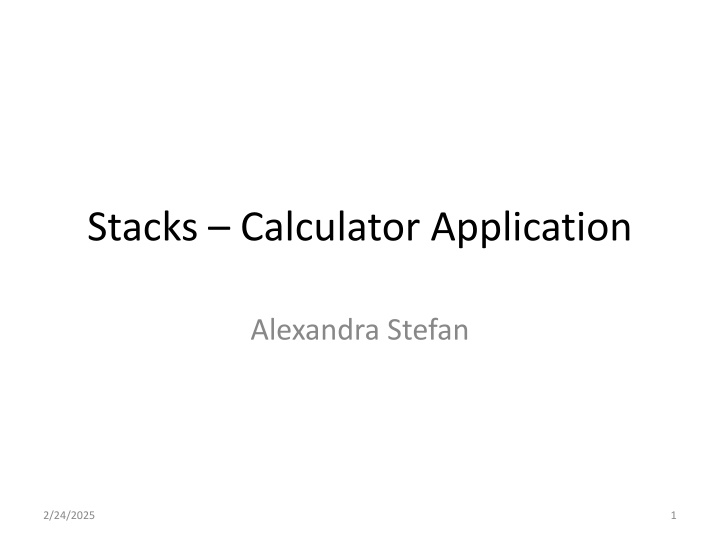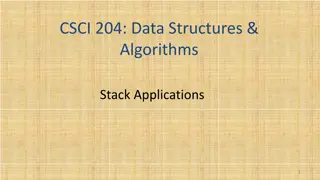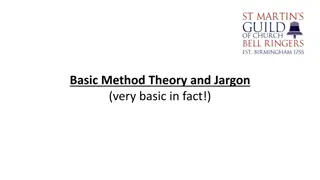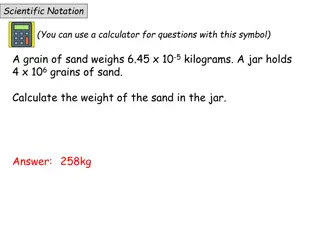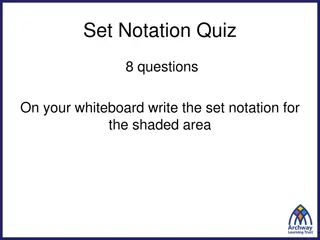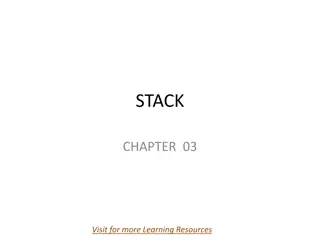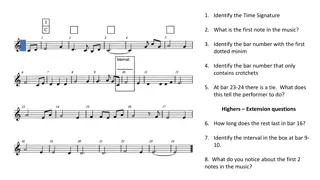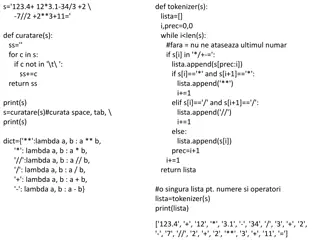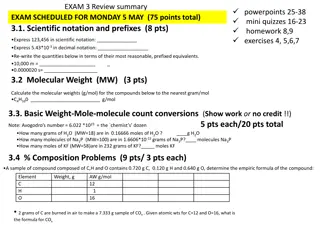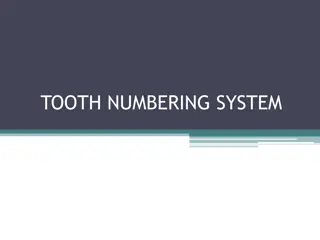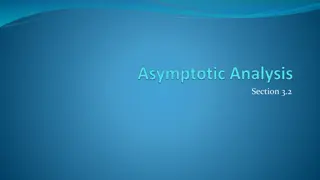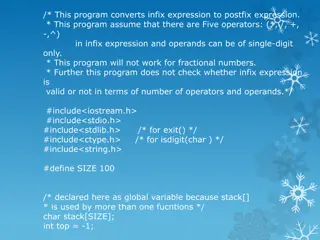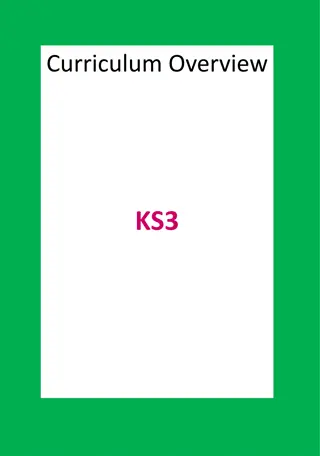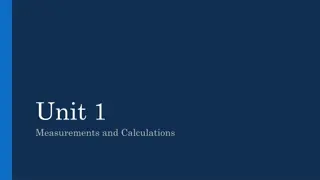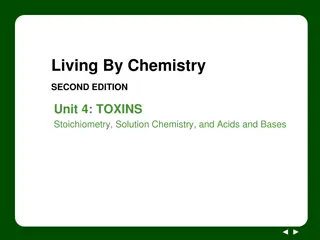Infix and Postfix Notation
Infix notation is the standard mathematical expression notation we use, where operators are between operands. Exploring prefix and postfix notations, which place the operator before or after the operands, respectively. Learn how to process symbolic expressions and convert infix to postfix notation using stacks efficiently. Tokens, operators, and numbers play key roles in these processes, making mathematical expressions easier to evaluate.
Download Presentation

Please find below an Image/Link to download the presentation.
The content on the website is provided AS IS for your information and personal use only. It may not be sold, licensed, or shared on other websites without obtaining consent from the author.If you encounter any issues during the download, it is possible that the publisher has removed the file from their server.
You are allowed to download the files provided on this website for personal or commercial use, subject to the condition that they are used lawfully. All files are the property of their respective owners.
The content on the website is provided AS IS for your information and personal use only. It may not be sold, licensed, or shared on other websites without obtaining consent from the author.
E N D
Presentation Transcript
Stacks Calculator Application Alexandra Stefan 2/24/2025 1
Infix and Postfix Notation The standard notation we use for writing mathematical expressions is called infix notation. The operators are between the operands. There are two alternative notations: prefix notation: the operator comes before the operands. postfix notation: the operator comes after the operands. operandoperator Example: infix: 5 * ( ( ( 9 + 8 ) * ( 4 * 6 ) ) - 7 ) prefix: (* 5 (- (* (+ 9 8) (* 4 6)) 7)) postfix: 5 9 8 + 4 6 * * 7 - * (use , if needed: 5, 9, 8, +, 4, 6, *, *, 7, -, * No parentheses needed. Can be easily evaluated using a stack. 2
Processing a Symbolic Expression How do we process an expression such as: 5 * ( ( ( 9 + 8 ) * ( 4 * 6 ) ) - 7 ) postfix: 5, 9, 8, +, 4, 6, *, *, 7, -, * Think of the input as a list of tokens. Assume it is already tokenized A token is a logical unit of input, such as: A number An operator A parenthesis. 3
Tokens A token is a logical unit of input, such as: A number An operator A parenthesis. What are the tokens in: 51 * (((195 + 8 ) * (4 - 6)) + 7) Answer: 51, *, (, (, (, 195, +, 8, ), *, (, 4, -, 6, ), ), +, 7, ) 19 tokens. Note that a token is NOT a character. For example 195 is one token, but it contains 3 charatcters. We will not discuss how to build tokens from characters. The numbers are the difficult part. 4
Converting Infix to Postfix Input: a list/stream of tokens in infix order. Output: a list of tokens in postfix order. Assumptions: 1. Each operator has two operands. 2. The input is fully parenthesized. Every operation (that contains an operator and its two operands) is enclosed in parentheses. Fully parenthesized Not fully parenthesized (not allowed as input) (3+5) 3+5 (2+(5-4)) (2+5-4) 2+(5-4) 2+((5-4)) ((2 + 9) - (4 + 5)) (2 + 9) - (4 + 5) 5
input: a stream of tokens in infix order. output: a list, result, of tokens in postfix order. (Uses a stack: op_stack ) result = empty list op_stack = empty stack while(the input stream is not empty) T = next token If T is left parenthesis, ignore. If T is a number, insertAtEnd(result, T) If T is an operator, push(op_stack, T). If T is right parenthesis: op = pop(op_stack) insertAtEnd(result, op) op_stack result list T 5 5 * * 2 5 2 + * + 8 5 2 8 ) * 5 2 8 + / * / 6 5 2 8 + 6 Infix Postfix - * / - 4 5 2 8 + 6 4 (5 * ( ( ( 2 + 8 ) / ( 6 - 4 ) ) - 7 ) ) ) * / 5 2 8 + 6 4 - ) * 5 2 8 + 6 4 - / - Numbers go in the result list - Operators go on the op_stack (the stack shown grows to the right) - Left parenthesis, (, are ignored. - At right parenthesis, ), pop operator from op_stack and add it to the result list. - * - 7 5 2 8 + 6 4 - / 7 ) * 5 2 8 + 6 4 - / 7 - 6 ) 5 2 8 + 6 4 - / 7 - *
Evaluating Expressions in Postfix Notation while(token list is not empty) T = remove next token (number or operator) from list. If T is a number, push(stack, T). If T is an operator: A = pop(stack) B = pop(stack) C = apply operator T on A and B (order: B T A, e.g.: B-A) push(stack, C) final_result = pop(stack) Input: a list tokens in infix order. Output: the result of the calculation (a number). Assumption: the list of tokens is be provided as input. Postfix: 5 2 8 + 6 4 - / 7 - * Token list: 5, 2, 8, +, 6, 4, -, /, 7, -, * 6-4 = 2 4 8 10/2 = 5 7 5-7 = -2 2+8 = 10 6 2 -2 2 5 10 5 5*(-2)=-10 10 10 5 5 5 5 5 -10 5 5 -10 + 5,2,8 * - 6,4 7 - / Here the * indicates the multiplication operator, not a pop() operation on the stack. We do not explicitly show the pop operations. Instead, for each operator we pop, pop, calculate, push. 7
input: a stream of tokens in infix order. output: a list, result, of tokens in postfix order. (Uses a stack: op_stack ) result = empty list op_stack = empty stack while(the input stream is not empty) T = next token If T is left parenthesis, ignore. If T is a number, insertAtEnd(result, T) If T is an operator, push(op_stack, T). If T is right parenthesis: op = pop(op_stack) insertAtEnd(result, op) op_stack result list T 5 5 * * 9 5, 9 + * + 8 5, 9, 8 ) * 5 , 9, 8, + / * / 4 5, 9, 8, +, 4 Infix Postfix * * / * 6 5, 9, 8, +, 4, 6 (5 * ( ( ( 9 + 8 ) / ( 4 * 6 ) ) - 7 ) ) ) * / 5, 9, 8, +, 4, 6, * ) * 5, 9, 8, +, 4, 6, *, / - Numbers go in the result list - Operators go on the op_stack (the stack shown grows to the right) - Left parenthesis, (, are ignored. - At right parenthesis, ), pop operator from op_stack and add it to the result list. - * - 7 5, 9, 8, +, 4, 6, *, /, 7 ) * 5, 9, 8, +, 4, 6, *, /, 7, - 9 ) 5, 9, 8, +, 4, 6, *, /, 7, -, *
Evaluating Expressions in Postfix Notation while(token list is not empty) T = remove next token (number or operator) from list. If T is a number, push(stack, T). If T is an operator: A = pop(stack) B = pop(stack) C = apply operator T on A and B (order: B T A, e.g.: B-A) push(stack, C) final_result = pop(stack) Input: a list tokens in infix order. Output: the result of the calculation (a number). Assumption: the list of tokens is be provided as input. Postfix: 5 9 8 + 4 6 * / 7 - * Token list: 5, 9, 8, +, 4, 6, *, /, 7, -, * 4*6 = 24 6 8 7 0.7-7 = -6.3 9+8 = 17 17/24 0.7 4 24 -6.3 9 0.7 17 0.7 5*(-6.3)= -31.5 17 17 5 5 5 5 5 -31.5 5 5 -31.5 7 - * 5,9,8 + 4,6 * / 10
